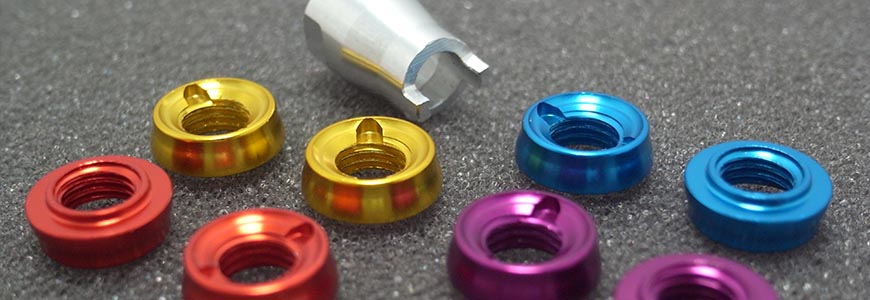8 Standard Metal Part Finishing Techniques

One of the many advantages of CNC machining is the decent level of cosmetic appearance evidenced in its finished parts. And while many product developers will take decent, more often than not, metal parts will require some extent of post-machining touches to emphasize the true elegance, aesthetic, and even functionality of the part. Here are eight standard metal finishing options for perfecting your metal parts.
1. Anodizing
Anodizing is a surface treatment, protection, and cosmetic-enhancing finishing technique used to introduce additional thickness to the inherent oxide layer that is found on the surface of the aluminum and metallic parts. Anodizing will prevent the surface of the part from corrosion and scratching. When used along with an array of colored dyes, it can be used to give the metal part a smooth matte finish.
2. Laser etching and engraving
Laser etching and engraving are used to add standout details, text, logos, or symbols on finished metal parts. The technology works by tuning lasers at high frequencies at the metal parts to achieve the desired pattern. Most metal parts with serial numbers, part numbers, popping patterns, and high-contrast symbols are all etched with lasers.
3. Powder coating
As the name implies, Powder coating involves coating the metal part with dry polymeric powder. This technique leverages the variances in electric potential to use electron charges to stick coat to a part.
The process uses an electrostatic gun to charge the spray powder to a positive state. This powder adheres to the metal part and is heat-cured to make the finish permanent. The advantage of powder coating is the many colors that can be experimented with. It also adds thickness to the walls of your part, so if a dimension is critical for you, you may want to consider how this technique influences your design.
4. Polishing
If you’ve ever seen a shiny, mirror-like finish in a high-grade metal part, you can achieve it through polishing. Polishing is a cosmetic and functional finishing technique that delivers parts’ clarity, reflectivity, or transparency. Because of the level of labor required, the technique can be relatively expensive, so it’s well worth it to wait till you’re producing your final parts for market entry.
5. Brushing
Brushing is used to produce a dull polished finish on metal parts. The finish resembles a satin-like texture, and the procedure uses a 120-180 grit belt. The finished part retains some metallic luster and inherits a pattern of parallel lines arising from the brushing action.
Unlike anodizing, brushing may inhibit or weaken the natural oxide later in some metals because abrasion is common with the process. This can enable rusting in the metal parts. It is particularly recommended for decorative products like watches and jewelries.
6. Sanding
Sanding is a basic yet versatile metal post-processing technique. It is done with a gritty sandpaper, which depends on the desired texture and level of finish. Through sandpaper, the metal can inherit a smooth luster, uniform, semi-smooth, relative to the size of the grits in the sandpaper. The downside of sanding is the cost and the time it takes. The time is taken to sand a metal part largely relies on the metal’s hardness. The advantage is the numerous levels of texture can be explored through sandpaper grit sizes.
7. Plating
Metal plating is a finishing process that delivers on both cosmetic and protective fronts. The procedure simply involves using a thin layer of another metal to coat the surface of a metal part. The thin material (plate) protects the metal surface from corrosion and rusting (oxidation). Plating can also be used to alter the cosmetic appearance of metal to resemble the plating metal. Chrome, Zinc, Tin, and Nickel are the most common plating techniques. Carbon steel and copper are the two metal materials that are most plated.
8. Media blasting
Media blasting is a metal finishing technique that is used to convey smooth, matter finish post-processing. The technique can use various materials, referred to as the media, to apply the desired texture in the metal by firing these small gritty materials at high speed. Common materials used in media blasting include sand beads and glass.
Premium Parts Finishing Services in China
Take advantage of our wide range of finishing services to make your product look and feel as you desire. Explore our standard metal part finishing services and contact our production experts to discuss how best to deliver aesthetic and cosmetic superiority to all your metal parts. Get in touch with us now and receive your free quote!






